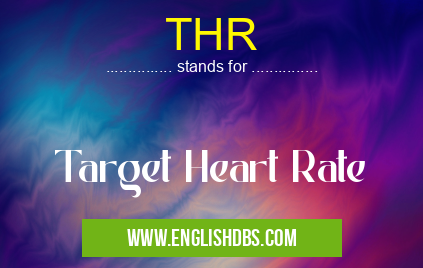What does THR mean in PHYSIOLOGY
Target Heart Rate (THR) is an indication of the desired intensity of a physical exercise which helps you monitor your progress and make sure that you are exercising at an appropriate level. It is essential to have an understanding of your THR so you can get the most benefit out of your workout without putting yourself in any danger.

THR meaning in Physiology in Medical
THR mostly used in an acronym Physiology in Category Medical that means Target Heart Rate
Shorthand: THR,
Full Form: Target Heart Rate
For more information of "Target Heart Rate", see the section below.
» Medical » Physiology
Benefits
Maintaining a target heart rate during exercise can be beneficial in many ways both physically and emotionally. Physically it helps improve overall cardiovascular fitness as well as increase energy levels, strengthen muscles, reduce weight, improve blood circulation and lower cholesterol levels; all things that contribute to better health and long-term wellness! Emotionally it can help relieve stress, improve moods and provide feelings of accomplishment; all things that can help lead one closer towards their health goals!
Essential Questions and Answers on Target Heart Rate in "MEDICAL»PHYSIOLOGY"
What is Target Heart Rate?
Target Heart Rate (THR) is the safe range of exercise intensity for achieving maximum health benefits from aerobic exercise. It is expressed as a percentage of your maximum heart rate, which is the highest number of beats per minute when your heart works at its hardest.
What is the formula to calculate THR?
You can calculate your maximum heart rate by subtracting your age from 220. To get your target heart rate, multiply this number with a desired intensity level (between 0.5 and 0.85). For example, if you are 30 years old, then your maximum heart rate should be 190 beats per minute (220 - 30). If you want to exercise at 70% of your maximum capacity for optimal health benefits, then your target heart rate would be 133 Beats Per Minute (190 x 0.7).
How often do I need to check my THR?
You should monitor your target heart rate throughout aerobic activity and adjust the intensity level accordingly to ensure you stay within the safe range for optimal health benefits. Depending on how intense you wish to exercise, it is recommended to check it before starting exercise and every 5 minutes or so during a workout session.
Why should I keep my workout within my THR?
Keeping yourself within the Target Heart Rate range ensures that you are performing aerobic exercises at an ideal level of intensity for gaining maximum health benefits such as improved cardiovascular health and better overall fitness. Exercising too intensely can increase chances of injury and also reduce potential health benefits.
What are some signs that I am working out beyond my THR?
If you are feeling exhausted or overly tired after exercising, then there's a possibility that you may have worked out beyond your THR range. Feeling breathless or having chest pains during or after exercising can also indicate overexertion.
Can I use HR monitors to track my THR during workouts?
Yes! Everyday wearables such as smartwatches and fitness trackers come equipped with advanced technology that allow users to accurately monitor their Target Heart Rate while working out. These devices measure various biometric data such as step counts, calorie burned and also analyze real-time vitals like heart-rate to track progress.
Final Words:
Target Heart Rate is a valuable tool for monitoring yourself during physical activity so you don't overexert yourself or put yourself at risk for injury or illness due to excessive exertion. With a little bit of math (or help from a medical professional) you can easily calculate what yours should be so you can stay safe while still getting the most out from each workout!
THR also stands for: |
|
| All stands for THR |
